Top News
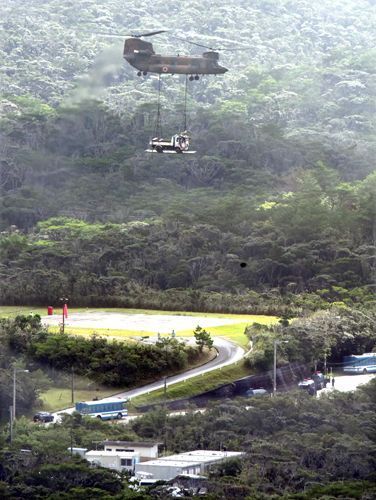
September 13, 2016 Ryukyu Shimpo
[Helipad reporting team] On September 13, shortly after 9 a.m., the Okinawa Defense Bureau began transporting heavy equipment using two Japan Self-Defense Force (JSDF) CH-47 helicopters. The equipment must be transported in order to construct new helicopter landing pads (helipads) in the U.S. military’s Northern Training Area, which spans across Higashi Village and Kunigami Village. As of 11 a.m., observers have spotted the helicopters making three trips carrying 4-ton trucks and work vehicles with caterpillar treads attached to the G and H zones. It is highly unusual for JSDF aircraft to be deployed for the construction of a U.S. military facility, and it is the first time heavy equipment has been transported by JSDF aircraft for the construction of helipads in the U.S. military’s Northern Training Area.
The heavy equipment hung from the JSDF aircraft as they flew over prefectural road 70 from inside the Northern Training Area’s main gate to the N1, G and H zones, on the other side of the road, where new helipads are to be constructed. Vehicles drive along the prefectural road, and residents are raising criticisms due to safety concerns.
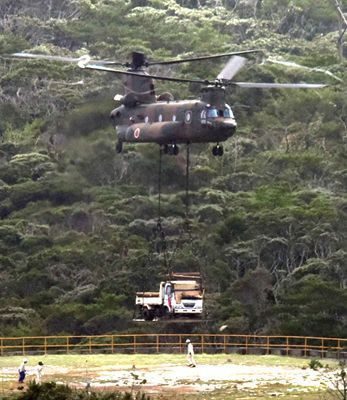
A JSDF CH-47 transport helicopter carries a large vehicle used for helipad construction in the U.S. military’s Northern Training Area on September 13 at 9:59 a.m. in Takae, Higashi Village (photograph taken by Futoshi Hanashiro)
Shortly after 6 a.m. on September 13, the JSDF aircraft were seen circling above the N1 zone. Thereafter, they landed on the helipad near the main gate. Shortly before 9 a.m., preparations commenced to begin moving the heavy equipment. The helicopters belong to the 1st Helicopter Brigade of the Central Readiness Force stationed at Kisarazu Air Field.
Protesters opposed to the construction have been engaging in direct action to prevent dump trucks from carrying gravel into the construction site. As of 11:30 a.m., no dump trucks have been spotted.
Protesters in front of the main gate raised their voices in anger in response to the tactic, saying “don’t fly over the prefectural road!” and “have you really gone so far as to use JSDF aircraft?”
(English translation by T&CT and Sandi Aritza)
Go to Japanese

September 11, 2016 Ryukyu Shimpo
On September 11, a proposed Okinawa research society of the East Asian Community (EAC) was launched at a symposium held at the University of the Ryukyus. Experts from both within and outside of Okinawa called for the society. It was established as a way to extensively research the current state of Okinawa’s right of self-determination, including Okinawan self-reliance and independence.
Former Prime Minister of Japan Yukio Hatoyama was brought in as an honorary advisor of the research society. He said he believes that Okinawa’s spirit of fraternity represents the true essence of the concept of an East Asian Community, and that Okinawa will be the starting point for the EAC. When a meeting of the EAC opens in Okinawa, he hopes it will paint a picture that the prefecture will serve as a pivot point toward peace.
Professor at University of the Ryukyus Tetsumi Takara, who has assumed a position as representative of the EAC, explained the reason why this research society is being established. He said that some of the main founding principles of the society are to help break Okinawa out of its current deadlocked condition of struggling with issues surrounding independence and democracy, to receive assistance from outside of the prefecture, and to gain recognition for Okinawa from all over East Asia.
The EAC has also taken on Professor Akira Kimura of Kagoshima University as a representative, and former governor of Okinawa Masahide Ota as an honorary advisor.
Some of those who gave reports at the symposium on September 11 were Professor Kimura, professor at University of the Ryukyus Jun Shimabukuro, president of Okinawa University Hiroshi Nakachi, emeritus professor at Okinawa University Masaie Ishihara, and Ai Tamaki of SEALDs RYUKYU.
Organizers of the symposium included professor at Tokyo Zokei University Akira Maeda, full-time lecturer at Kyoto Seika University Satoshi Shirai, and numerous researchers and journalists from both within and outside of Okinawa.
Former Prime Minister Hatoyama serves as board chairman for the East Asian Community Institute, which is a separate organization from the EAC.
(English translation by T&CT and Erin Jones)
Go to Japanese
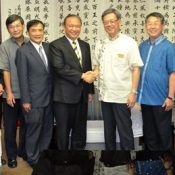
September 7, 2016 Ryukyu Shimpo
On September 6, Northeastern Taiwan’s Yilan County established an office in Kumoji, Naha City to promote cultural exchange in the fields of sightseeing and business, and among fishermen. According to a person involved in the establishment of the office, this is the first time a municipality from Taiwan has set up an office in Okinawa. Magistrate of Yilan County Lin Tsung-hsien, as chairman of the board of the Taiwan Okinawa Association, declared that the aim of this office was to be a place for “a deepening of cultural exchange in every field, such as economics and education.”
Lin visited Governor Takeshi Onaga the same day at the Okinawa Prefectural Office, and spoke to him about Yilan County’s new office. According to Lin, one person will be in charge of the office for now. In addition, Lin requested that Onaga come to visit Yilan County. Onaga said that Taiwan and Okinawa are like siblings, and that he wants them to “build a strong relationship and advance together.” He voiced his desire to visit Yilan County, also.
Okinawa and Yilan County have the same purpose in promoting cultural exchange between fishermen, since fishermen of Okinawa and Yilan County have been at odds with each other since the enactment of the Taiwan-Japan Fisheries Agreement. Lin says that fishermen of both regions seek out many of the same species of fish, such as Bluefin tuna. He went on to say the goal of this office is to create a platform for fishermen of Okinawa and Yilan County to cooperate, rather than compete with each other.
During his visit to Okinawa, Lin went to see Okinawa IT Shinryo Park. He explained that Yilan County is planning to install an intelligent transportation system, and that if he finds a good system, he hopes to adopt it. In addition, Japan’s nursing industry is more advanced than Taiwan’s, so he wanted to observe it.
(English translation by T&CT and Erin Jones)
Go to Japanese
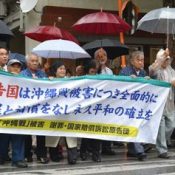
September 7, 2016 Ryukyu Shimpo
On September 6, at the Naha branch of the Fukuoka High Court, the first argument for an appeal trial in which plaintiffs are demanding an apology and compensation from the government to be granted to Battle of Okinawa war victims was held.
The government’s attorney argued that the appeal should be dismissed.
The lead attorney for the plaintiffs Shigeru Zukeyama argued in his opening statement, “If the plaintiffs lose the lawsuit, the damages they suffered during the Battle of Okinawa will be forever lost in the darkness of history. But the fact that the law was not able to protect the weakest people would forever be engraved in history.”
The leading attorney criticized the lower court’s decision for totally rejecting the demand of the plaintiffs without considering the uniqueness of the Battle of the War. He indicated that the Imperial Japanese Army had forced local residents out of shelter caves.
He also mentioned that the lower court’s ruling did not refer to PTSD from the war, and criticized the court for avoiding its responsibility to make a judgement on a unique case.
Tsuru Kinjo, an 80-year-old war orphan living in Kitanakagusuku Village spoke to the court as a plaintiff. She lost seven family members after they were forced out of their shelter cave by the Imperial Japanese army.
Weeping, she told the judges about how she had thought of killing herself. The war orphan plaintiff said, “I want this issue to be resolved while my health is still good.”
The government’s attorney argued that the plaintiffs’ appeal should be dismissed because it was before the enforcement of the national compensation law and the government does not therefore have any responsibility to compensate.
The government’s attorney took the same stance taken in the lower court ruling.
(English translation by T&CT)
Go to Japanese
September 6, 2016 Ryukyu Shimpo
Takamatsu Gushiken, a representative of the volunteer group that collects remains from the Battle of Okinawa, Gamafuya, has requested permission to conduct a survey and collect the remains at the Ourasaki Internment Camp burial site in Camp Schwab, the U.S. military base in Henoko, Nago City. The request was sent via email to both the U.S. embassy as well as the U.S. military headquarters in Japan on September 5. Permission to conduct surveys and collect remain in the U.S. facilities is traditionally granted by the Japanese government. However, Gushiken requested permission from the U.S. military directly this time. Gushiken emphasized, “I want the U.S. military to recognize their responsibility in forcibly removing the residents and taking their freedom at the Ourasaki Internment Camp.”
As of 8 p.m. on September 5, there had not been a response from the U.S. military as to whether it would approve the request to conduct remains collections in Camp Schwab. In the written request, Gushiken stressed, “The residents were forcibly removed, and numerous people died due to lack of food, starvation and malaria. Such cruel deaths were institutionalized by the U.S. military in contravention of international laws.” He further claimed, “The collection of remains is not a domestic issue but an issue between the U.S. military and Okinawa.’”
Regarding Ourasaki Internment Camp, the Okinawa prefectural and the Japanese governments conducted an assessment based on a testimony from a woman in her 80s in June this year. However, no remains were found.
Gushiken stated, “The woman’s testimony was only about a part of the burial site and it is not fair to falsify findings from this partial area as the whole area. We are preparing new testimonies.”
(English translation by T&CT and Sayaka Sakuma)
Go to Japanese

September 5, 2016 Hanae Gushiken Higa Correspondent of Ryukyu Shimpo
From August 25 to October 2, a play titled “UchinaAloha” by Okinawan playwright Lee Tonouchi will be performed at Kumu Kahua Theater in Honolulu.
According to Tonouchi’s description of the play, the protagonist is a fourth-generation “Local” Okinawan and college drop out who grew up in Hawaii David Yonamine. It was his mother’s wish that he would “learn how to play sanshin from his grandfather.” However, David is not amenable to the idea and has mixed feelings. One day, David meets an exchange student from Okinawa, Maria Ginoza.
Lee Tonouchi is a fourth generation Okinawan. When his uncle Mac Yonamine used lament to Lee that he no longer hears Uchinaguchi in Okinawa, Lee did not care so much. However, when Lee participated in a class called “Shimakutuba” taught by Professor Masahide Ishihara at the University of the Ryukyus in September 2012, he learned that Uchinaguchi is endangered. Impressed by a passionate lecture, Lee wrote UchinaAloha.
In the production, David plays “Mensore Hawaii” with Sanlele (an instrument that combines sanshin and ukulele). This music was composed by world famous ukulele player Jake Shimabukuro, who is a fifth generation Okinawan.
(English translation by T&CT and Megumi Chibana)
Go to Japanese
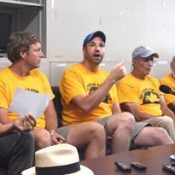
September 9, 2016 Ryukyu Shimpo
On September 8, six members of Veterans for Peace (VFP), a peace organization made up of military veterans, who are visiting Okinawa held a press conference at the Okinawa Prefectural Office. The veterans said that visiting Okinawa brought home to them the fact that the presence of the U.S. military brings nothing but destruction to the earth, peace, and the environment. They expressed determination to actively speak out about their experiences in Okinawa and the situation here after returning to the United States, and to make a broad call for support in preventing the construction of a new U.S. base in Okinawa.
The group came to Okinawa on August 30 in the hopes of deepening their understanding about the U.S. base issues in Okinawa. They will return to the United States on September 9. During their time in Okinawa, they joined protest rallies against the construction of helipads held in front of the N1 gate in Takae, Higashi Village, and also joined Okinawa’s peace movement protesting in front of Futenma and Kadena Air Stations, engaging with Okinawan residents.
Tarak Kauff, who was a paratrooper in the U.S. Army’s from 1959 to 1963 expressed that having seen the tragedies of the battlefield firsthand, he knows that further U.S. military expansion is impermissible. He said emphatically that now is the time for the U.S. military to leave Okinawa.
Will Griffin, a former member of the U.S. Army who participated in the protests at Takae, said that the sight of Okinawan people and Japanese riot police clashing over the presence of the U.S. military was very strange, and that it vividly showed that Japan is still a colony of the United States.
(English translation by T&CT and Sandi Aritza)
Go to Japanese
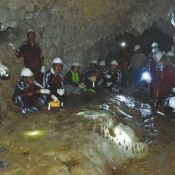
September 2, 2016 Ryukyu Shimpo
A non-profit organization called shizen taiken gakko (Nature Experience School) Okinawa branch in Yaese Town held a clean-up event at a battle site in Iriyuji-gama cave in Gushikami, Yaese Town, on August 21. Twenty-seven participants from Gushikami Junior High School and the general public attended the event to clean up litter around the cave and to learn about the local historical battle site.
The Iriyuji-gama was used by soldiers belonging to the Japanese Imperial army as the headquarters for the 5th troop from the 89th Infantry Regiment. The cave was also used as a storage space for documents from the Gushikami village office. Seventy-one years after the war, the cave is still not well known among the neighboring residents, and it has been degraded by illegally dumped waste around its entrance.
The chief leader of the NPO group, Tomoya Yoshimura, explained the purpose of the event, saying, “By cleaning up the battle site, we can let people know about the presence of such a cave in Yaese Town. I hope this place can be a space used for peace education in future.”
After the event, the participants entered into the cave and received instructions on how the cave was used in the war. A senior student of Gushikami Junior High School Shota Nakama remarked, “The preservation situation was pretty bad with a lot of waste, so I’m glad I was able to attend this event. I think it’s important to continue informing people about how such a battle site existed in Yaese Town.”
(English translation by T&CT and Sayaka Sakuma)
Go to Japanese
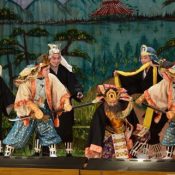
August 29, 2016 Ryukyu Shimpo
For three days from the 16th to 19th of August, Shichigachi mura odori was held at Henoko Exchange Plaza in Henoko, Nago City. More than 100 residents performed traditional dances and gave thanks for fertility.
Shichigachi mura udui is held every three years in Henoko. On the 16th and 18th, more than 20 dances pieces and Kyogen were performed. On the 19th, Kumiodori Yaguranuhiya was performed. Many residents and people from other communities joined the event and enjoyed the traditional performance.
Before presenting on stage, the youth performed a valiant Sumakibo in the front yard of the community hall. The stage performance on the 16th and 18th began with Maikata and celebratory dances such as Chojano ufusyu and Shochikubai were performed. A humorous Kyogen titled Nitohei monogatari (Story of Buck Private) was performed including a scene when Japanese soldiers make fun of their boss. The act brought laughter and applause.
A Kumiodori titled Yaguranuhiya was the only piece performed on the 19th. It is a long story that takes about one and half hours with 15 characters. In the story, the owner of Kochi domain, Yaguranuhiya, plots to assassinate Tsukenda nu aji (Ryukyuan local chief) and Tanahara nu aji. The sons of the two aji, Yamato and Torachiyo take revenge for their fathers. The performers’ had clearly worked hard to prepare with their unique songs, utasanshin, and other instruments coming together harmoniously.
President Yasuhide Miyagi of Henoko Performing Arts Preservation Group and Ward Mayor Sokatsu Kayo said, “It was wonderful as a whole. I would like to pass this on to the next generation.”
(English translation by T&CT and Megumi Chibana)
Go to Japanese
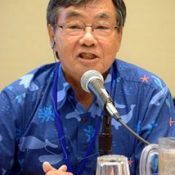
September 6, 2016 Ryukyu Shimpo Washington correspondent Sakae Toiyama reports from Honolulu
On September 4, Nago Mayor Susumu Inamine presented at a workshop at the sixth International Union for Conservation of Nature (IUCN) World Conservation Congress. At the workshop, Inamine reported on the issue of the new base construction being carried out as part of the relocation of U.S. Marine Corps Air Station Futenma to Henoko, Nago City. “I want to bring back safety, peace of mind and tranquility to the people of Okinawa prefecture as soon as possible. I hope you will give us your support as partners,” Inamine said, calling on the international community to support efforts to prevent the new base construction. The IUCN has adopted recommendation proposals regarding the new base four times, and Inamine urged them to check up on the situation to see whether the recommendations are being followed.
Mayor Inamine pointed out the flaws in the environmental impact assessment for the new base construction, saying, “More than 100 hectares of ocean will be filled in, but the government says that the impact on the environment will be small. Oura Bay, where the construction is planned to take place, remains home to abundant nature. The environmental assessment cannot be called scientific.”
Mayor Inamine also explained that he submitted a written opinion regarding problems with the environmental assessment, including issues relating to environmental conservation, the habitat of the dugong, and the sand and soil that will be used for the land reclamation, but the Japanese government never referred to it.
Regarding the IUCN’s recommendations, Inamine said, “Japan never even glanced at them. The Japanese government needs to sincerely consider [the recommendations].”
He also criticized the Japanese government for pushing forward with the new base construction, saying, “It must be said that [the government] is trampling on human rights and democracy, and is denying local autonomy.”
Participants at the workshop offered opinions and suggestions, such as consulting with experts, discussing the issue with an IUCN representative, and the need for the municipal government to bring in experts and have them clearly lay out the environmental issues involved.
At a news conference held before the work shop, Mayor Inamine reported on the situation in Okinawa regarding the new base construction and said, “I want our voices to be heard. I have hope for the insights and cooperation of experts. I hope they will offer us their assistance.”
(English translation by T&CT and Sandi Aritza)
Go to Japanese
September 2, 2016 Ryukyu Shimpo
Authorized NPO and human-rights body Human Rights Now issued statement criticizing the Japanese government for violently cracking down non-violent protesters in Okinawa. It came ahead of the United Nations Human Rights Council (HRC) 33rd regular session, which will be held from September 13. The statement said the Japanese government is suppressing citizens protesting against construction of a new military base in Henoko and helipads in Takae with brute force. It urged the government to stop taking excessive security measures and violently removing the protesting citizens, stating, “The Japanese government should guarantee Okinawan people’s right of self-determination and end the excessive concentration of U.S. military bases on Okinawa.”
Japan will be evaluated by the Universal Periodic Review of HRC in 2017. It is possible the government’s forcible removal of the protesting citizens in Henoko and Takae will be exposed to international community as a serious breach of human rights.
Jun Shimabukuro, professor at the University of the Ryukyus who is acquainted with HRC, said the statement could raise questions with HRC, which is made up of 47 member nations. Shimabukuro said, “What the statement said will not be immediately discussed by HRC. However, it is possible that the human rights situation in Japan could be known to the international community, which could lead to the situation being improved in the future.”
In the statement, Human Rights Now pressed the Japanese government to guarantee freedom of assembly, freedom of the press and also admit Okinawans as indigenous people. The organization holds a general consultative status with the UN.
(English translation by T&CT)
Go to Japanese










 Webcam(Kokusai Street)
Webcam(Kokusai Street)


